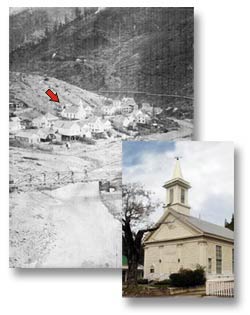 Methodist Church of Downieville
Methodist Church of Downieville
Construction of the Methodist Church of Downieville also began in 1853, the same year as the First Catholic Church. However, the Methodist church, which also served as the area's Episcopal church, was not completed until 1856, This original structure is still in use today and is now California's oldest Protestant church building in continuous use. Prior to the church being constructed, the town's folk were holding Sunday services in other buildings. The construction site of the Methodist Church of Downieville had not been mined, so once construction was complete, the property was mined via tunneling – once using gravel to support the foundation and again using dirt that had to be taken in by wheel barrow.
Of all the gold mined from beneath the Methodist church, the congregation never received any of the profits. A new floor was constructed in 1960, at which time a cavity 7 feet in diameter and several feet deep was discovered. No wonder the church's foundation had continued to settle so drastically, causing such continued necessary repairs. Not even churches were sacred when it came to gold mining in the 1800's.
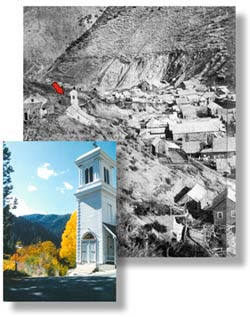 The First Catholic Church of Downieville
The First Catholic Church of Downieville
was a simple structure built in 1853 under the direction of Father Shanahan, a priest who had visited the mining camp after a devastating fire in 1852 had burned down most of the communities buildings.
The church was active even though it didn’t have a permanent pastor. Father Dalton traveled frequently from Grass Valley to the northern corners of Sierra County, including to Downieville when in 1856 he purchased a former Baptist church for $2,300. On June 22, 1856, the church was dedicated as “The Assumption.” In the winter of 1856, Father Charles Delahunty became pastor of the Downieville parish.
When that building burned down on Jan. 1, 1858, Father Delahunty had the present church built up the hill, approximately 150 yards north of the former site and dedicated this new structure as “The Immaculate Conception.”
While guarding his own flock, Father Delahunty also traveled to the many other mining towns of Sierra County until 1861, when he was transferred to Virginia City.
To this day, The Immaculate Conception Church still serves the residents of Downieville.
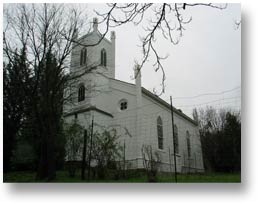 Emmanuel – Coloma
Emmanuel – Coloma
The towering Emmanuel Church in Coloma was constructed beginning in 1855 and completed in 1856, six years after the Episcopal congregation was formed. There are no records of where the church members met prior to the presence of the new building. The township's mission work began in 1849 with the arrival of Rev. William Roberts and continued with Silas F. Bennett, who continued later that year after being sent to Coloma by General John Sutter to complete the mill. A newspaper article, dated Sept. 29, 1855 reads:
The Ladies of Emmanuel Church will hold a Ladies’ Fair Oct. 5. The attendance of a great number of ladies from adjoining towns is anticipated and gentlemen will do well to make note of the time.
In 1870, the building became the Methodist-Episcopal Church. In 1921, the Methodists took ownership of the property and building and that year made extensive improvements. The church was in use as a house of worship until 1963 when it was deeded to the California State Parks division. The park rangers maintain the historical church and it is still available for weddings.
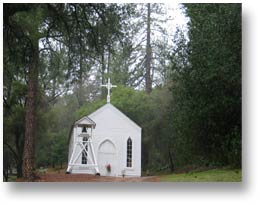 St. John's – Coloma
St. John's – Coloma
St. John's Catholic Church is not the congregation's original meeting place. A small log church was built in 1856 but as the membership grew the need for a larger building was fulfilled in 1858 with the construction of this standing building. Unfortunately this little church fell into severe disrepair as the fortunes and citizens of Coloma dwindled over the next century. It was successfully rescued in 1972 when it was lovingly restored. The original bell, cast in Sheffield, England in 1860, remains in the bell tower and the original stone foundation was built so tightly that no mortar was needed. It also remains in tact. Inside, some of the fine original pews have been polished to a beautiful luster and the Stations of the Cross are still in place. Behind the church is the Catholic Cemetery, which contains 77 graves. The first date of burial is 1850, that of D.A. MacPhee, so the cemetery began before the church building was erected. Coloma's St. John's Catholic Church and the Emanuel Church are just a stone’s throw from each other on Church Street.
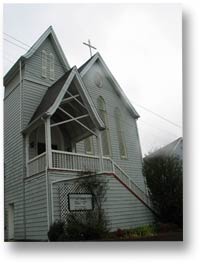 Placerville Episcopal
Placerville Episcopal
Through the efforts of a young man by the name of Rev. Charles Caleb Pierce, Placerville's Episcopal Church was erected in 1865, four years after the Catholic Church was built. Originally a Quaker, Rev. Pierce was apparently a popular man. There are records of the Pierce Ladies Guild who raised money and received donations in order to build the church that still sits on Coloma Street right near today's Highway 50. In their efforts to collect enough money to finish the church, Pierce received $1,500, which came from four saloonkeepers. The profession of saloon keeping was not held in high esteem, yet after their donations Rev. Pierce had this to say: “There are some excellent and high principled saloonkeepers, as I can attest.” Placerville's Episcopal Church is still in use today.
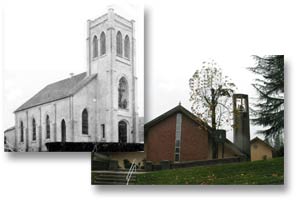
Placerville Catholic Church
“A substantial frame church was erected on Sacramento Street,” according to an 1852 document that records the first semblance of a Catholic Church in Placerville, then called Dry Diggins. The original name came from the fact that there was not much water with which to mine the gold. After three men were hanged from an oak tree in the middle of town, the community was hung with the unofficial moniker of Hangtown. Lawlessness soon became much less of a problem because of the name. But since the townsfolk were too crazy about their nickname, it officially changed to Placerville in 1854.
The new, modern church you see today stands on the same spot as the original but still another building was on that sight in between. The first building was destroyed by fire in 1865. All that was left of it was the beautiful bell, which had been a gift from some miners. It was cast with a considerable amount of silver in it. A new church went up in August 1865. Dry Diggins’ first Catholic priest was a missionary by the name of F. Ingoldsby, who arrived in town in 1852.
At least two other historic churches, dating from the mid-1800s, graced Placerville but they fell into such severe disrepair, they were eventually demolished in the 20th century.
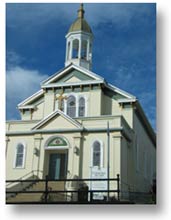 St. Patrick Catholic Church & Rectory - Jackson
St. Patrick Catholic Church & Rectory - Jackson
Daniel Harter and his carpenters built this graceful church on Church Street in downtown Jackson in 1868. However, local Catholics had been gathering for mass in various homes since 1852. In 1853, Armstead C. Brown sold them his former residence, which they had been using for church services and it sufficed until 1855 when a new church was built. The 1862 fire consumed that building and in 1868 the current church took its place. A new bell arrived in 1870 but in 1878, it was blown down along with the belfry and cross, which wasn’t replaced until 1894. Part of the accompanying rectory was added next door in 1887; with another half added some time after 1919. St. Patrick’s Catholic Church continues to house its faithful to this day.
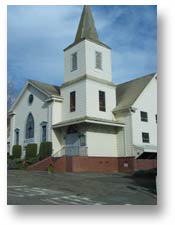 Methodist Church & Parsonage - Jackson
Methodist Church & Parsonage - Jackson
The original Methodist-Episcopal Church was built in 1853, however the same denominations were erected in Fort John, Volcano and Ione prior to Jackson's. The building survived the 1862 fire because it was far enough away from the blaze. In 1968, the wood structure was demolished to make room for the present brick construction. The existing parsonage next door was constructed in 1893. Thanks to a 23-year-old minister, Isaac B. Fish, and his seemingly frail and delicate wife, the Methodist-Episcopal church was finally a reality in Jackson. Fish traveled by foot (he could not afford to own or feed a horse) to Jackson from Mokelumne Hill and surrounding communities beginning in 1851. He preached in homes, frequently to less than a handful of people. During one sermon, a knife fight broke out. Fish declared of Jackson: “The Lord have mercy on the wicked people of Jackson.” But his persistence finally paid off.
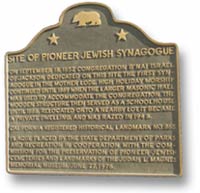 Pioneer Jewish Synagogue - Jackson
Pioneer Jewish Synagogue - Jackson
While Jewish tradesmen, peddlers and merchants arrived in Jackson in 1849, it wasn't until September 1857 that the Mother Lode's first Jewish Synagogue was dedicated and opened for the first time. In July 1857, the Amador Ledger reported: “The Israelites of Jackson have commenced the construction of what will be, when finished, one of the largest and finest churches in the mountains.” John Edwards, of Ione Valley, and A.C. Brown, of Jackson, donated the land on which the synagogue stood, surrounded by the Jewish cemetery. Historians believe that the synagogue was only used for annual high holy days each September and was left locked the rest of the year. After 1868, the building was used for secular purposes and was demolished in 1876, just 19 years after it's construction. Today a monument to the Jewish Synagogue stands in front of the Jackson Grammar School on Church Street. (Courtesy of Larry Cenotto)
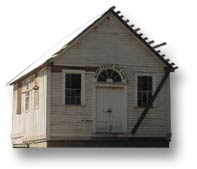 St. Peter and Paul's - Jackson
St. Peter and Paul's - Jackson
The tiny, crude church of St. Peter and Paul's was originally built in the town of Clinton, south of Jackson. Mere signs of Clinton no longer exist. Believed to have been built in 1877, the small building was moved to the Kennedy Mine site, in the town of Jackson in the last few years. Also relocated at the Kennedy Mine site is a Jackson bridge originally built in 1908. St. Peter & Paul's church can be visited at the mine site on Jackson Gate Road. (Courtesy of Larry Cenotto)
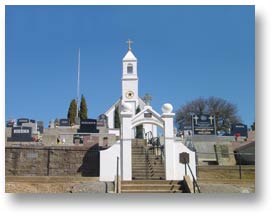 St. Sava Serbian Church – Jackson
St. Sava Serbian Church – Jackson
On a hillside in Jackson, in a neighborhood once known as Newmanville, stands the spectacular St. Sava Serbian Church, built in 1894. Majestic headstones in the cemetery surround the massive snow-colored church. St. Sava (pronounced Saba) was the first Serbian Church built in North America to serve the spiritual needs of the countless Serbian miners who came to the Gold Country to pluck their riches. Prior to the church's construction, the “Slavonian Benevolent Society” was formed in Sutter Creek between 1872 and 1874, depending on which historical account you read. After their Sutter Creek “church meeting place” burned down in 1881, Jackson became their focal point. Construction was completed in December 1894 using brick fired in Jackson. Originally planned as a “Greek Orthodox” church, the Serbian/Slavonian residents were successful in procuring a Serbian charter and thus became the mother church of North America.
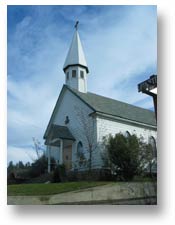 The Mokelumne Hill Community Church
The Mokelumne Hill Community Church
celebrates its 152nd birthday in 2005, with old and new members invited. The church was built in 1853 as the Congregational Church and was headed by Rev. Benjamin D. Henry, of Maine. The original building burned down in the fire of 1854 and the church that visitors see today was
built and dedicated in 1856. Services have taken place in this church continuously over the last century and a half.
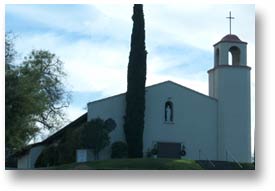 The Catholic Church in San Andreas
The Catholic Church in San Andreasbegan with the transfer of raw land from Charles H. Schroebel and Daniel Pillsbury to
No comments:
Post a Comment